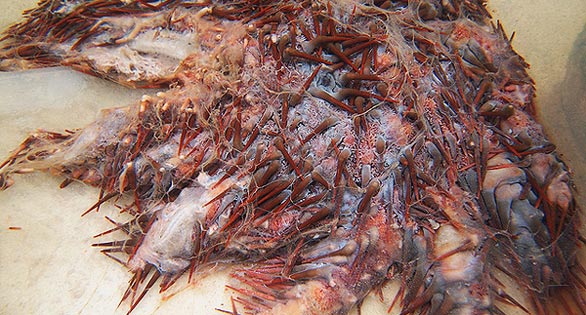Researchers Stumble Upon Lethal Control for Crown of Thorns Starfish
An Australia-based team of marine scientists has developed what may prove an effective control for the dreaded Crown of Thorns starfish (COTS), which periodically ravages coral reefs across the Pacific and Indian Oceans and is a major cause of coral losses on the Great Barrier Reef.
With signs that the starfish is building up for another huge attack in the Pacific and Australian region, their solution could come in the nick of time.
The researchers, from the ARC Centre of Excellence for Coral Reef Studies (CoECRS) at James Cook University (JCU) have discovered that a harmless protein mixture used to grow bacteria in the laboratory can destroy the starfish in as little as 24 hours.
If subsequent tests show it is safe for other sea life, their breakthrough could yield a dramatic improvement in ability to control of COTS outbreaks, even if only to protect sites that are intensively used for tourism.

Dr. Jairo Rivera Posada, veterinarian and marine researcher at the ARC Centre of Excellence for Coral Reef Studies, James Cook University.
“A Crown of Thorns outbreak can destroy from 40-90 per cent of the corals on a reef. Over the past 50 years it has caused more damage than bleaching,” says Dr. Jairo Rivera Posada “There were massive outbreaks in many countries in the 1960s and 1980s – and a new one is well underway on the Great Barrier Reef.”
Dr. Posada, who trained as a vet before switching to marine research, was on the beach with Professor Morgan Pratchett of CoECRS at Lizard Island in the Northern Great Barrier Reef when he wondered if the substance he was using in the lab to selectively culture the Vibrio bacteria that naturally inhabit the starfish could give the bugs enough of a boost to damage their host.
Rushing back to their tanks, they quickly injected five starfish with the media culture solution – made from carbonates and proteins extracted from animal tissues – and were astonished when the starfish rapidly began to fall apart and die as the bacteria attacked them.
“I was only hoping to impair their immune systems – so the fact that they died so quickly was a great surprise,” Jairo says.
Looking more closely, the researchers found that the solution had caused the bacteria to bloom and attack the starfish; at the same time the starfish suffered an acute allergic reaction to the unfamiliar animal proteins (mainly derived from cattle). Furthermore, the bacteria also spread under favourable conditions to other starfish which came in contact or close to the infected individual.
This ‘double whammy effect caused by an otherwise harmless protein mixture has opened up the possibility of developing a safe, convenient and fast way of killing Crown of Thorns starfishes, explains Prof. Morgan Pratchett of CoECRS and JCU.

Prof. Morgan Prachett: “In the current COTS outbrak in the Philippines they removed as many as 87,000 starfish from a single beach….”
“In developing a biological control you have to be very careful to target only the species you are aiming at, and be certain that it can cause no harm to other species or to the wider environment,” says Prof. Pratchett. “This compound looks very promising from that standpoint – though there is a lot of tank testing still to do before we would ever consider trialling it in the sea.”
Prof. Pratchett says starfish outbreaks in the vicinity of specific tourist sites are currently controlled using a poison injection delivered by a diver – but we need to find more effective and efficient control methods if we are to scale-up control programs.
Dr Rivera adds that the protein solution needs only a single jab into a starfish, enabling a diver to kill as many as 500 Crown of Thorns in a single dive – compared with 40 or so using the poison injection. Nevertheless, stopping an established outbreak of millions of starfish will not be feasible. It is already too late to stop the current outbreak, they say.
“In the current COTS outbreak in the Philippines they removed as many as 87,000 starfish from a single beach. This gives you an idea of the numbers we have to deal with,” he adds. Other fresh COTS outbreaks have been reported from Guam, French Polynesia, Papua New Guinea, and the central Indian Ocean.
The team is about to embark on extensive testing to establish the technique is safe for use around corals, fish, other types of starfish, sea urchins and sea cucumbers.
They are also exploring other natural parasites and disease-causing organisms for controlling Crown of Thorns, as well as simple protein injections which trigger a fatal allergic reaction. However, any attempts to control these outbreaks will be futile without also addressing the root cause of outbreaks, including loss of starfish predators as well as increased nutrients that provide food for larval starfishes.
Source:
From materials released by the ARC Centre of Excellence: CORAL REEF STUDIES






Trackbacks/Pingbacks